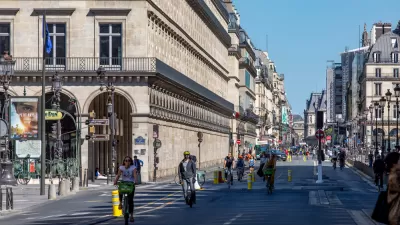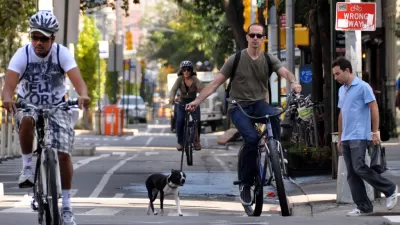Checking in with the Bike(+) Plan in Pittsburgh.

"It is Earth Week and Pittsburgh is in the midst of a battle over asphalt," writes John Shumway. "Drivers want every inch they can get while the city is trying to make bicycle riders safer."
According to the article, the city of Pittsburgh is making progress on a plan that would bring the city's total of bike lanes above 250 miles. The city last year added 13 miles of bike facilities to an existing 60 miles, according to Karina Ricks, the director of mobility and infrastructure for the city, who is cited throughout the article touting the benefits of bike infrastructure.
According to Ricks, the city is preparing to add new bike lanes on Fifth Avenue, in an existing bus only lane, and on Forbes Avenue uptown. The city also recently added its first Bicycle Traffic Signal at the intersection of Penn and Stanwix.
Despite the "batle" framing in the lede, no anti-bike-lane backlash is described in the article. Ricks does discuss, however, the importance of bike lanes for post-pandemic mobility—expecting congestion to increase as more people buy more cars and stay away from public transit.
FULL STORY: City Of Pittsburgh To Add Hundreds Of Miles Of New Bike Lanes To Existing Network

Trump Administration Could Effectively End Housing Voucher Program
Federal officials are eyeing major cuts to the Section 8 program that helps millions of low-income households pay rent.

Planetizen Federal Action Tracker
A weekly monitor of how Trump’s orders and actions are impacting planners and planning in America.

Ken Jennings Launches Transit Web Series
The Jeopardy champ wants you to ride public transit.

Crime Continues to Drop on Philly, San Francisco Transit Systems
SEPTA and BART both saw significant declines in violent crime in the first quarter of 2025.

How South LA Green Spaces Power Community Health and Hope
Green spaces like South L.A. Wetlands Park are helping South Los Angeles residents promote healthy lifestyles, build community, and advocate for improvements that reflect local needs in historically underserved neighborhoods.

Sacramento Plans ‘Quick-Build’ Road Safety Projects
The city wants to accelerate small-scale safety improvements that use low-cost equipment to make an impact at dangerous intersections.
Urban Design for Planners 1: Software Tools
This six-course series explores essential urban design concepts using open source software and equips planners with the tools they need to participate fully in the urban design process.
Planning for Universal Design
Learn the tools for implementing Universal Design in planning regulations.
Heyer Gruel & Associates PA
Ada County Highway District
Institute for Housing and Urban Development Studies (IHS)
City of Grandview
Harvard GSD Executive Education
Toledo-Lucas County Plan Commissions
Salt Lake City
NYU Wagner Graduate School of Public Service





























